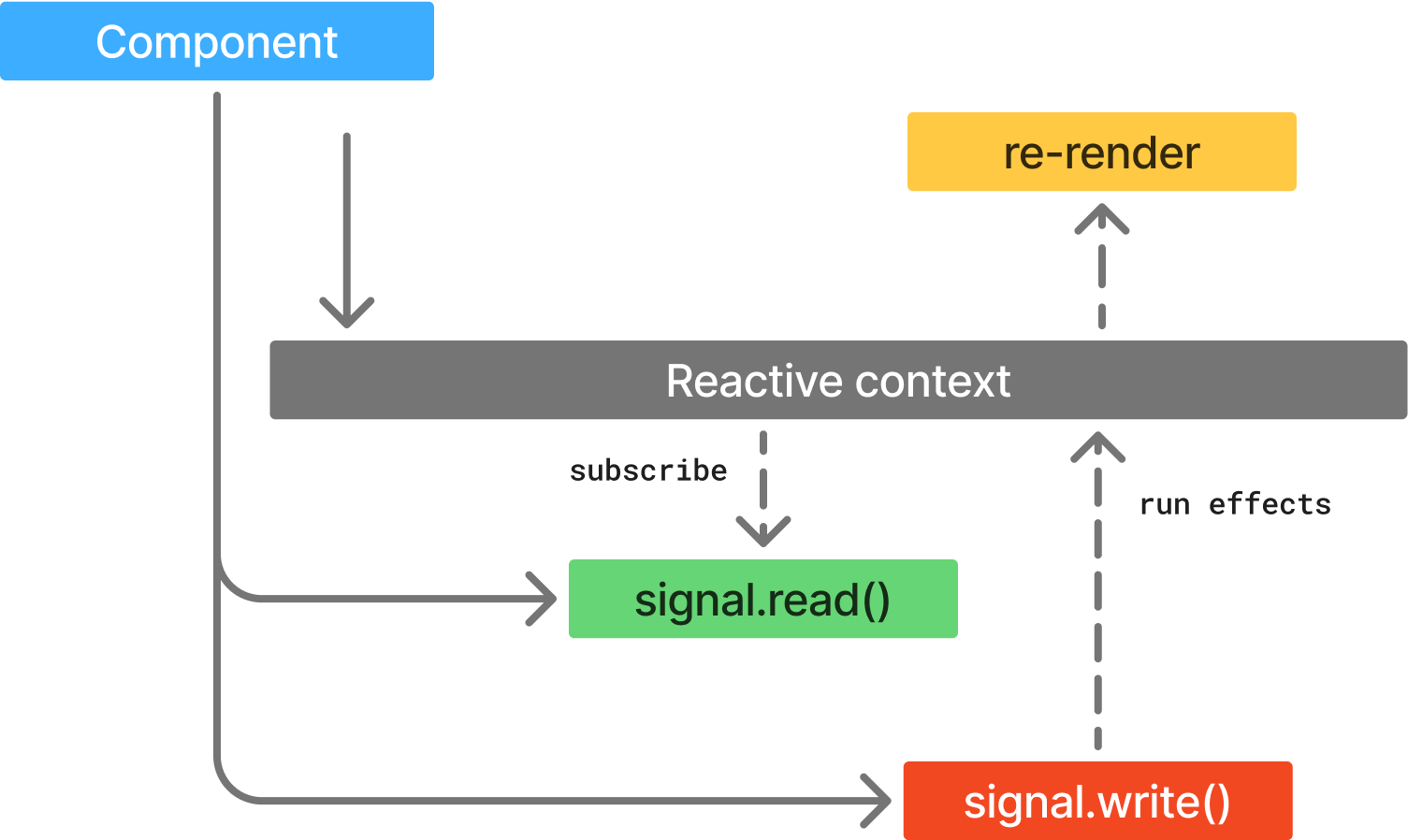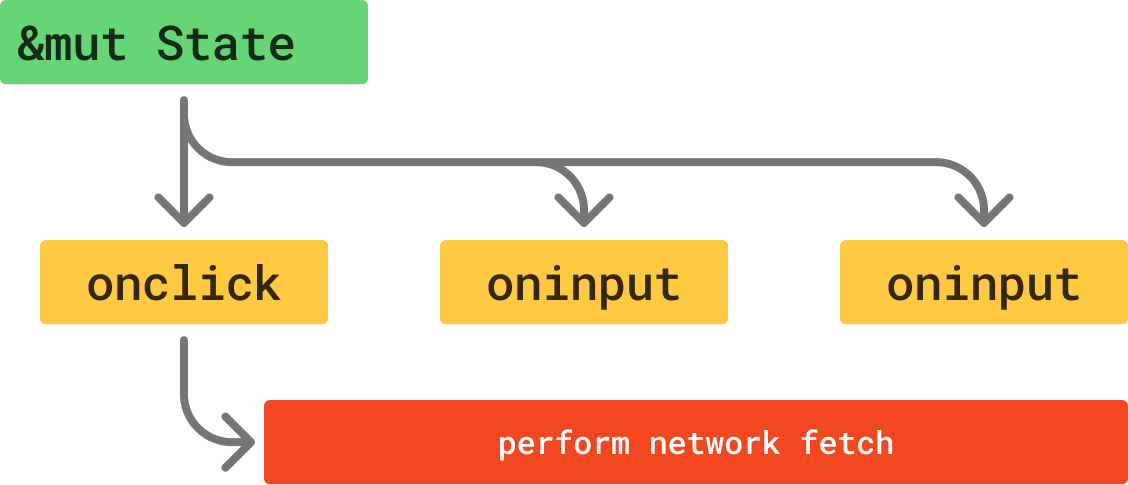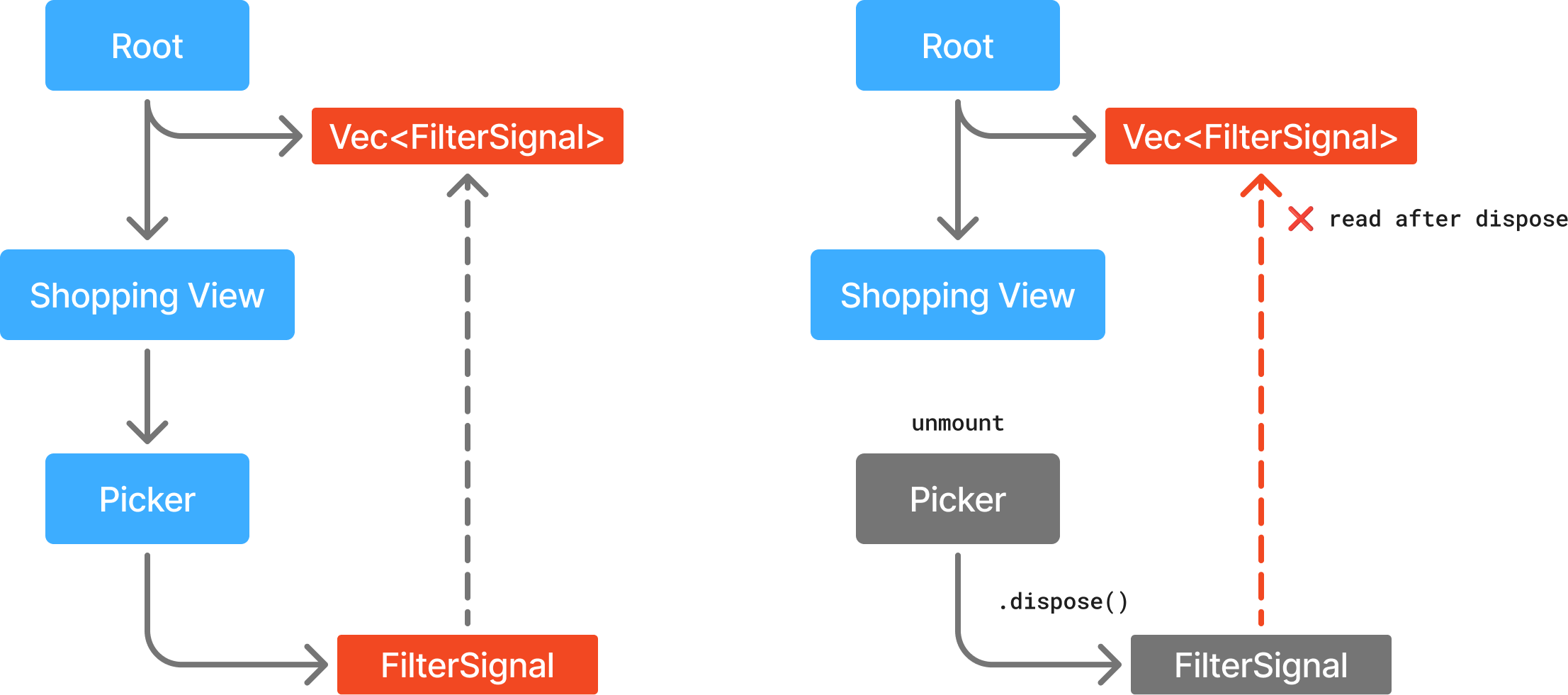Reactive Signals
In Dioxus, your app's UI is defined as a function of its current state. As the state changes, the components and effects that depend on that state will automatically re-run. Reactivity automatically tracks state and derives new state, making it easy to build large applications that are efficient and simple to reason about.
Dioxus provides a single source of mutable state: the Signal.
State with Signals
In Dioxus, mutable state is stored in Signals. Signals are tracked values that automatically update reactive contexts that watch them. They are the source of state from which all other state is derived from. Signals are modified directly by event handlers in response to user input or asynchronously in futures.
You can create a signal with the use_signal hook:
let mut signal = use_signal(|| 0);
Once you have your signal, you can gain a reference to the signal's inner value by calling the .read():
let mut signal = use_signal(|| 0); // use `.read()` to access the inner value let inner = signal.read();
For Signals whose inner can be cheaply cloneable, you can also use "function" syntax to get a direct Clone of the value.
let name = use_signal(|| "Bob".to_string()); // Call the signal like a function let inner = name(); // Or use `.cloned()` let inner = name.cloned();
Finally, you can set the value of the signal with the .set() method or get a mutable reference to the inner value with the .write() method:
// Set the value from the signal signal.set(1); // get a mutable reference to the inner value with the .write() method let mut value: &mut i32 = &mut signal.write(); *value += 1;
A simple component that uses .read() and .write() to update its own state with signals may look like:
fn Demo() -> Element { let mut count = use_signal(|| 0); // read the current value let current = count.read().clone(); rsx! { button { onclick: move |_| *count.write() = current, "Increment ({current})" } } }
When assigning values to a .write() call, note that we use the dereference operator which let's us write a value directly into the mutable reference.
Ergonomic Methods on Signals
In some cases, wrapping your data in Signals can make accessing the inner state awkward. Mutable Signals implement two fundamental traits: Readable and Writable. These traits provide a number of automatic ergonomic improvements.
Signal<T>implementsDisplayifTimplementsDisplaySignal<bool>implementsfn toggle()Signal<i32>and other numbers implement math operators (+, -, /, etc)Signal<T>whereTimplementsIntoIteratorimplements.iter()- and many more!
The Display extension enables using signals in formatting expressions:
let mut count = use_signal(|| 0); rsx! { "Count is: {count}" }
The toggle extension makes toggling boolean values simpler:
let mut enabled = use_signal(|| true); rsx! { button { onclick: move |_| enabled.toggle(), if enabled() { "disable" } else { "enable" } } }
Math operators simplify arithmetic operations:
fn app() -> Element { let mut count = use_signal(|| 0); rsx! { h1 { "High-Five counter: {count}" } button { onclick: move |_| count += 1, "Up high!" } button { onclick: move |_| count -= 1, "Down low!" } } }
The iterator extension makes iterating through collections easier:
fn app() -> Element { let names = use_signal(|| vec!["bob", "bill", "jane", "doe"]); rsx! { ul { for name in names.iter() { li { "hello {name}" } } } } }
You'll generally want to use the extension methods unless the inner state does not implement the required traits. There are several methods available not listed here, so peruse the docs reference for more information.
ReadSignal and WriteSignal
Dioxus provides two variations of the base Signal type: ReadSignal and WriteSignal.
ReadSignal: a read-only version of the base Signal typeWriteSignal: a read-write version of the base Signal type, equivalent toSignalitself
ReadSignals are reactive values that are implement the Readable trait. WriteSignals are reactive values that implement the Writable trait.
These two variations are useful when writing components that need to be generic over their input types. If a component only needs the .read() method and its extensions, then it can specify a ReadSignal as an argument.
fn app() -> Element { let mut name: Signal<String> = use_signal(|| "abc".to_string()); rsx! { // The rsx macro automatically converts the Signal into a ReadSignal Name { name } } } // We can accept anything that implements `Into<ReadSignal>` #[component] fn Name(name: ReadSignal<String>) { rsx! { "{name}" } }
In Dioxus, Signal is not the only reactive type. The entire ecosystem is full of custom reactive types. Dioxus itself also provides additional reactive types like Memo and Resource. To integrate well with the broader ecosystem, it's best to prefer using ReadSignal and WriteSignal in your interfaces rather than specific reactive types.
This ensures we can pass both Signal and Memo to the same function:
let name: Signal<String> = use_signal(|| "abc".to_string()); let uppercase: Memo<String> = use_memo(move || name.to_uppercase()); rsx! { // The rsx macro automatically converts the Signal into ReadSignal Name { name, uppercase } // The rsx macro automatically converts the Memo into ReadSignal Name { uppercase } } #[component] fn Name(name: ReadSignal<String>) { rsx! { "{name}" } }
Reactive Scopes
A Reactive Scope is a block of Rust code that observes reads and writes of reactive values. Whenever .write() or .set() is called on a Signal, any active reactive scopes tracking that Signal run a callback as a side-effect.
The simplest reactive scope is a component. During a component render, components automatically subscribe to signals where .read() is called. The .read() method can be called implicitly in many circumstances - notably, the extension methods provided by Readable use the underlying .read() method and thus also contribute to the current reactive scope. When a signal's value changes, components queue a side-effect to re-render the component using dioxus::core::needs_update.
let mut name = use_signal(|| "abc".to_string()); rsx! { // An explicit call to `.read()` {name.read().to_string()} // An implicit call via `Display` "{name}" }
If a component does not call .read() on a Signal while rendering, it does not subscribe to that signal's value. This provides us "zero cost reactivity" where we can freely modify signal values without worrying about unnecessary re-renders. If a value is not observed, it won't cause unnecessary re-renders.
let mut loading = use_signal(|| false); rsx! { button { // Because we don't use "loading" in our markup, the component won't re-render! onclick: move |_| async move { if loading() { return; } loading.set(true); // .. do async work loading.set(false); } } }
Calls to .read() access the current reactive scope, adding this scope to the list of subscribers to the Signal with a side effect that runs when that signal is changed. For components, the logic causes the component to queue a re-render side effect.

There are other uses of reactive scopes beyond component re-renders. Hooks like use_effect, use_memo, and use_resource all implement functionality by leveraging a reactive scope that exists outside the rendering lifecycle.
Automatic Batching
All built in hooks batch updates if possible. Instead of running effects immediately, .write() calls queue an effect before the next "step" of your app. The runtime will try to wait until all writes in the current step are complete before running any effects. This provides automatic batching of .write() calls which is important both for performance and consistency in the UI.
By batching .write() calls, Dioxus ensures that our example UI always displays one of two states:
- "loading?: false -> Complete"
- "loading?: true -> Loading"
let mut loading = use_signal(|| false); let mut text = use_signal(|| "Complete!"); rsx! { button { onclick: move |_| async move { // these writes are batched and side-effects are de-duplicated text.set("Loading"); loading.set(true); // awaiting a future allows the runtime to continue do_async_work().await // these writes are also batched - only one re-render is queued text.set("Complete!"); loading.set(false); }, "loading?: {loading:?} -> {text}" } }
Dioxus uses await boundaries as barriers between steps. If state is modified during a step, Dioxus prefers to paint the new UI first before polling additional futures. This ensures changes are flushed as fast as possible and pending states aren't missed.
While dioxus tries to batch writes, it prefers consistent state over batching when the two are in conflict. If you read the result of a memo directly after writing to a signal it depends on, the memo will be re-evaluated immediately to ensure you get the most up-to-date value. This ensures the memo is always equivalent to running the memo's function directly.
let mut count = use_signal(|| 0); let double = use_memo(|| *count() * 2); rsx! { button { onclick: move |_| async move { // This queues a rerun of the memo and marks it as dirty count += 1; // This forces the memo to re-evaluate immediately println!("double is now: {}", double()); }, "doubled: {double}" } }
Signals are Borrowed at Runtime
In Rust, the &T and &mut T reference types statically assert that the underlying value is either immutable or mutable at compile time. This assertion brings a number of guarantees, enabling Rust to generate fast and correct code.
Unfortunately, these static assertions do not mix well with asynchronous background tasks. If our onclick handler spawns a long-running Future that captures an &mut T, we can not safely handle any other events until that Future completes:

At times, our UIs can be very concurrent. There are ways to re-orient how we concurrently access state that are compatible with Rust's static mutability assertions - unfortunately, they are not easy to program.
Instead, Signals provide a .write() method that checks at runtime if the value is safe to access. If you're not careful, you can combine a .read() and a .write() in the same scope, leading to a runtime borrow failure (panic).
This is most frequently encountered when holding .read() or .write() refs across await points:
let mut state = use_signal(|| 0); rsx! { button { // Clicking this button quickly will cause multiple `.write()` calls to be active onclick: move |_| async move { let mut writer = state.write(); sleep(Duration::from_millis(1000)).await; *writer = 10; } } }
Fortunately, this code fails cargo clippy because the writer type should not be held across an await point.
Thankfully, Signals guard against the "trivial" case because the .write() method takes an &mut Signal. While the .write() guard is active in a scope (block), no other .read() or .write() guards can be held:
let mut state = use_signal(|| 0); rsx! { button { // rust prevents this code from compiling since `.write()` takes `&mut T` onclick: move |_| { let cur = state.read(); *state.write() = *cur + 1; } } }
We get a very nice error from the Rust compiler explaining why this code does not compile:
error[E0502]: cannot borrow `state` as mutable because it is also borrowed as immutable --> examples/readme.rs:22:18 | 21 | let cur = state.read(); | ----- immutable borrow occurs here 22 | *state.write() = *cur + 1; | ^^^^^^^^^^^^^ mutable borrow occurs here 23 | } | - immutable borrow might be used here, when `cur` is dropped and runs the destructor for type `GenerationalRef<Ref<'_, i32>>`
If we do want to read and write in the same scope, we need to stage our operations in the correct order such that the .read() and .write() guards do not overlap. Usually, this is done by deriving an owned value from the .read() operation to be used in the .write() operation.
let cur = state.read().clone(); // calling `.clone()` releases the `.read()` guard immediately. *state.write() = *cur + 1;
Note that Rust automatically drops items at the end of a scope, unless they are manually dropped sooner. We can use the .read() guard provided it's dropped before .write() is called.
This is done either by creating a new, shorter scope to access the .read() guard -
// The .read() guard is only alive for a shorter scope let next = { let cur = state.read(); println!("{cur}"); cur.clone() + 1 }; // we can assign `state` to `next` since `next` is not referencing `.read()`. *state.write() = next;
or, simply by calling drop() on the guard
let cur1 = state.read(); let cur2 = *cur1 + 1; drop(cur1); // dropping early asserts we can `.write()` the signal safely *state.write() = cur2 + 1;
In very advanced use cases, you can make a copy of the signal or use the read_unchecked method to relax the borrowing rules:
match result.read_unchecked().as_ref() { Ok(resp) => rsx! { "success! {resp}" } Err(err) => rsx! { "err: {err:?}" }, }
Rust 2021 had issues with
.read()in match statements, whereas Rust 2024 fixes this issue, meaning you no longer need to useread_unchecked
While this might seem scary or error prone, you will very rarely run into these issues when building apps. The .read() and .write() guards respect Rust's ownership rules within a given scope and concurrent scopes are protected by the Clippy await_holding_refcell_ref lint.
Signals implement Copy
If you've used Rust to build other projects - like a webserver or a command line tool - you might have encountered situations with closures, threads, and async tasks that required an Arc or Rc to satisfy the borrow checker.

If our data is used across several parallel threads, or even just held in a callback, we might need to wrap it in an Arc or Rc smart pointer and .clone() it. This can lead to cumbersome code where we constantly call .clone() to share data into callbacks and async tasks.
let state = Arc::new(123); // thread 1 std::thread::spawn({ let state = state.clone(); move |_| println!("{state:?}"), }) // thread 2 std::thread::spawn({ let state = state.clone(); move |_| println!("{state:?}"), })
Unfortunately, UI code constantly encounters this problem - this is why Rust does not have a great reputation for building GUI apps!
To solve this, we built the generational-box crate that provides a GenerationalBox type that implements Rust's Copy trait. The Copy trait is very important: Rust automatically copies Copy types (when needed) on boundaries of scopes.
let state = GenerationalBox::new(123); // the `move` keyword automatically copies the GenerationalBox! std::thread::spawn(move |_| println!("{state:?}")); // we can easily share across threads with no `.clone()` noise std::thread::spawn(move |_| println!("{state:?}"));
Instead of copying the underlying value, the GenerationalBox simply copies a handle to the value. This handle is essentially a runtime-verified smart pointer. Accessing the contents of a signal is not as efficient as reading a pointer directly - there is an extra pointer indirection and lock - but we expect most code to not be bottlenecked by reading the contents of a GenerationalBox.
Dioxus Signals are built directly on top of GenerationalBox. They share the same Copy semantics and ergonomics, but with the same tradeoffs.
Signals are Disposed
Signals implementing Copy is a huge win for ergonomics. However, there is a tradeoff. The GenerationalBox type does not have automatic RAII support. This means when a GenerationalBox is dropped, its resources are not immediately cleaned up. It can be tricky to correctly use GenerationalBox directly. Dioxus manages the resource lifecycle by cleaning up resources using the component lifecycle.
The Signal type is built on GenerationalBox. Whenever you call use_signal, we automatically:
- Call
Signal::new() - Register
signal.dispose()on the component'son_drop
Whenever a component is unmounted, its hooks are dropped. When you create Signals in a component, each Signal is registered with a Signal "owner" on that component. When the component is unmounted, the owner drops, and in its Drop implementation, it calls .dispose() on all Signals that were created in its scope.
Effectively, we connected the .dispose() method of the Signals to the unmount of the component.
Because the Signal is disposed when the component unmounts, reading it after will cause a runtime panic. This very rarely happens in practice, but is possible if you "save" the signal in a component higher up the tree. Doing so would violate the one-way-data flow pillar of reactivity, but is technically possible.

Reading a Signal after it's been disposed is similar to the "use-after-free" bug with pointers, but reading a Signal is not undefined behavior. In debug mode, the Signal will be hoisted to its reader and you'll receive a warning in the logs that a Signal is being read after it's been disposed.
A similar issue can arise when you call Signal::new() directly. Dioxus creates an implicit Signal owner that is owned by the current component. The contents of this Signal will only be dropped when the current component is unmounted. Calling Signal::new() can lead to unbounded memory usage until the component is dropped. It's rare to do this in normal application code but can crop up in library development.
let mut users = use_signal(|| vec![]); rsx! { button { // the underlying strings won't be dropped until the component is unmounted, or you call `.dispose()` manually onclick: move |_| { users.write().push(Signal::new("bob".to_string())); }, "Add a new user" } }
When mapping Signals or creating them on-the-fly, it's best to prefer the built-in methods and reactive collections.
Effects, Memos, and More
Signals are just one piece of the Dioxus reactivity system. Hooks like use_effect and use_memo are able to isolate their reactive scopes to just callbacks and futures. This means .read() and .write() in these scopes won't queue re-render side-effects in their containing component.
We cover these hooks in more depth in a later chapter.